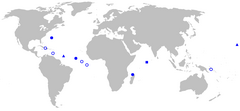Rhynchactis
| Rhynchactis | |
|---|---|
| Scientific classification | |
| Kingdom: | Animalia |
| Phylum: | Chordata |
| Class: | Actinopterygii |
| Order: | Lophiiformes |
| Family: | Gigantactinidae |
| Genus: |
Rhynchactis Regan, 1925 |
| Type species | |
|
Rhynchactis leptonema Regan, 1925 |
|
 |
|
| Occurrences of Rhynchactis (click for key) | |
Rhynchactis is a genus of deep-sea anglerfish in the family Gigantactinidae, containing three species found worldwide at depths greater than 400 m (1,300 ft). Adult female Rhynchactis reach a standard length (SL) of 11–13 cm (4.3–5.1 in) and have a dark-colored, streamlined body and a relatively small head bearing a very long illicium (the "fishing rod" formed by the first ray of the dorsal fin). Unlike almost all other deep-sea anglerfishes, the illicium bears no bioluminescent esca (the "lure") at the tip. The mouth is almost devoid of teeth, and the inside of both jaws are covered by numerous white glands that are unique to this genus.
The lack of an esca, greatly reduced dentition, and glands inside the mouth all point to Rhynchactis having a highly specialized mode of feeding, the nature of which has yet to be deciphered. As in other deep-sea anglerfishes, there is enormous sexual dimorphism with males being much smaller than females and lacking an illicium, though they do not appear to be parasitic as in some families. Reproduction is oviparous, with the larvae having a rounded shape and enlarged pectoral fins.
British ichthyologist coined the genus Rhynchactis and described its first species, R. leptonema, in a 1925 issue of Annals and Magazine of Natural History. The generic name comes from the Greek rhynchos ("snout") and aktis ("ray"), while the specific epithet comes from the Greek leptos ("thin") and nema ("thread"). Regan based his account on a single metamorphosed female collected by the research vessel Dana in the western central Atlantic.
...
Wikipedia
